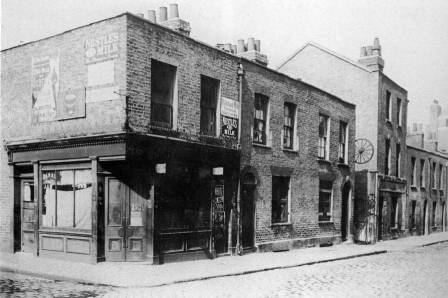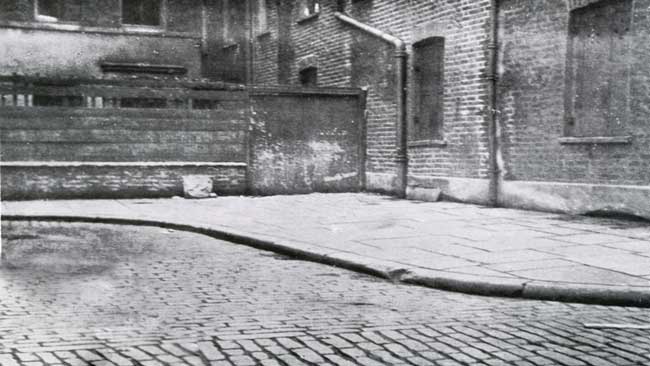As dawn broke on the 30th September 1888, the streets of the East End of London were witness to a flurry of Police activity. The Whitechapel murderer had struck in the early hours of the morning and, this time, had claimed the lives of two victims.
Furthermore, one of the two victims had been murdered in the City of London; and this meant that a second police force the City of London Police – was now involved in the hunt for the elusive fiend.
THE BERNER STREET MURDER
The body of the first victim – whom we now know to have been Elizabeth Stride – had been found at 1am in Dutfield’s Yard, a dark yard off Berner Street.

THE FINDING OF THE BODY
Her body had been discovered by Louis Diemshutz, the steward of a club that sided on to Dutfield’s Yard.
He had returned to the yard just before 1am, having spent the day hawking jewellery over in Crystal Palace. As he turned in to the gates of the Dutfield’s Yard, his pony suddenly shied and, jumping down to see what had alarmed it, he found the body on the ground.
It later transpired that her murderer had only cut her throat and had not performed his, by now horribly familiar, mutilations on the rest of the body. This led to the presumption that Diemshutz had, in fact, interrupted the killer.
PC LAMB ARRIVES
The chaotic scenes around the site where the murder had occurred were described by Police Constable Lamb at the inquest into the woman’s death and were reported by the St James’s Gazette on the 3rd of October 1888:-
“The inquest on the body of the woman known as Elizabeth Stride, who was murdered in Berner-street, Commercial-road, was resumed by Mr. Wynne E. Baxter, coroner for South-East Middlesex, yesterday, at the Vestry Hall, Cable-street.
Police-constable Henry Lamb said: On Sunday morning last about one o’clock I was in the Commercial-road, between Christian-street and Batty-street. Two men came running to me and said “Come on, there has been another murder.”
I asked where, and they pointed to Berner-street.
Seeing people moving about some distance down the street I ran, followed by another constable.
I went into the gateway of No. 40, and I saw something dark lying on the right-hand side close to the gate. I turned my light on and found it was a woman. I saw her throat was cut, and she appeared dead.
I at once sent the other constable for the nearest doctor.
I sent a young man to the station to inform the inspector.
There were about thirty people in the yard when I got there. No one was touching the body.
A crowd pushed round me as I was looking at the body, and I begged them to keep back, as they might get blood on them and get themselves into trouble. I put my hand on the face and the arm. They were slightly warm. I did no more, but blew my whistle.
The woman was lying on her left side. The left arm was lying underneath and the right arm was across, the breast. The face was about six inches from the wall. The clothes were not disturbed.
In reply to further questions, the witness stated that the doctor and a police inspector arrived shortly afterwards.
The gates were then closed, and all the people in the club were examined before they were allowed to go.
He also examined the dustbin and went into the cottages within the yard, but discovered nothing….”
A MYSTERIOUS WITNESS
Although, as can be seen from the above inquest testimony, the police, the authorities and the press were certain that the victim’s name was Elizabeth Stride within a day or so of the murder, a positive identification was delayed for several weeks thanks to the appearance of a mysterious witness by the name of Mary Malcolm, who claimed that the woman was, in fact, her sister, Elizabeth Watts.
You can read the full story of this miss-identification in this article.
THE MURDER OF CATHERINE EDDOWES
However, what neither Police constable Lamb, nor any of those people standing in Dutfield’s Yard that morning could have realised was that the murderer was, at that very moment, out on the streets in search of another victim.
And, within 45 minutes, news was circulating that there had been a second murder, just a stone’s throw away, in Mitre Square on the eastern fringe of the City of London.
At 1. 45am, Police Constable Watkins of the City of London Police, turned in to Mitre Square and noticed a bundle lying on the ground in the Square’s south-west corner.
Going to inspect it, he recoiled in horror at the sight that greeted him, the horrifically mutilated body of Catherine Eddowes.
If the Whitechapel murderer had been denied the satisfaction of mutilating the body of Elizabeth Stride, his thirst for blood had been more than quenched in Mitre Square. The face and the lower abdomen of this victim had been horrifically mutilated in what had, evidently, been a frenzied attack.

ANOTHER POLICE FORCE NOW INVOLVED
As previously mentioned, the fact that Mitre Square was in the City of London meant that this crime had been carried out in the jurisdiction of a different police force; and so the City of London Police now became involved in the hunt for the Whitechapel Murderer.
Despite the fact that they seemed more willing to talk to and share information with journalists than their counterparts in the Metropolitan Police – and as a consequence received better press – the identity of the perpetrator would, ultimately, prove as elusive to them as it had been, and would remain, to the Metropolitan Police.
WAS SHE A PROSTITUTE
It is often said of Jack the Ripper’s victims that they were all prostitutes – and, indeed, the newspapers of the day certainly did propagate this idea by constantly referring to them as being drawn from the “unfortunate” class.
However, at the inquest into the death of Catherine Eddowes, it is interesting to note that this point was raised and that several of those who knew her were insistent that she hadn’t been a prostitute.
Reporting on the inquest on Thursday the 11th of October 1888, The Cornish Telegraph had this to say:-
On Thursday Dr. Longhorn, City Coroner, opened an inquest on the body of the woman murdered in Mitre Square, Aldgate, on Sunday morning.
Eliza Gold was the first witness.
She identified the body as that of her sister, Catherine Eddowes, a single woman, who had lived with a man named John Kelly for some years.
She had previously lived with a man named Conway, an army pensioner, and had several children by him.
John Kelly, labourer, corroborated this, and said that he last saw deceased on Saturday afternoon at two o’clock, when they parted on good terms in Shoreditch.
Deceased proceeded to Bermondsey to see a daughter.
She did not return, but witness made no inquiries, believing she would return on Sunday.
Deceased never went out for immoral purposes.
They arrived together from Kent last week and spent the night at the Shoe-lane casual ward and on Friday they arranged that the deceased should go to the Mile-end Workhouse.
Frederick Wilkinson, deputy of the lodging-house in Flower and Dean-street, corroborated Kelly’s evidence, and said that deceased did not walk the streets.
Constable Watkins deposed to finding the mutilated body in Mitre Square.
Dr. Gordon Brown, the City Police surgeon, said that the manner in which the body was mutilated was horrible in the extreme…”
NOT SPEAKING ILL OF THE DEAD?
It is possible, some might even say probable, that the witnesses who were emphatic that Catherine Eddowes wasn’t a prostitute did so out of a desire to not speak ill of the victim. It might be argued that John Kelly’s assertion that the deceased “never went out for immoral purposes” may have been made because he was in denial of how she made her money, he might even have been afraid to admit that he had profited from her “immoral” activities.
Yet, the assertion that she wasn’t a street prostitute was also corroborated by Frederick Wilkinson who also stated, on oath, that “the deceased did not walk the streets.”
Of course, today, with the passage of 128 years, it is now impossible for us to say with certainty whether or not Catherine Eddowes was a prostitute, but it is important that the testimony of those who knew her should be heard and remembered.
VISIT THE SITES ON YOUR TOUR
On our tour you can follow the events of this night as Jack the Riper Tour guides Richard Jones, John Bennett and Lindsay Siviter, will take you on a tour of the East End streets where the mystery of the “double event” unfolded.
A CHANGE IN ATTITUDES
What is noticeable about the “double murder” of Elizabeth Stride and Catherine Eddowes, is that there was a change in mood in the immediate aftermath, and an element of street pantomime seems to have entered the mystery.
This, it must be said, was encouraged by the police decision to make public the infamous dear boss letter that bore the chilling signature “Jack the Ripper.”
However, there also appears to have been a general change in attitude to the murders as well, which can be seen in this article, which appeared in The Pall Mall Gazette in early October 1888.
Indeed, it could be argued that, it was in the aftermath of the so-called “double event” that the legend of Jack the Ripper was born; as it was that name which turned a series of sordid East End murders into an international phenomena and gave the unknown perpetrator of the crimes an immortality that stil seems to increase with every year that passes.
Indeed, it often gets forgotten that, at the centre of this mystery, lie five women who, no matter what their lifestyles, certainly didn’t deserve the horrific ends that they endured.
So, today, let’s all remember, with affection, the two victims, Elizabeth Stride and Catherine Eddowes; may they rest in peace.
